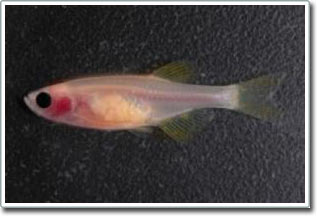Study zebrafish throughout
Genetically, zebrafish are similar to humans and are useful experiments for studying disease and human biology. Currently, scientists from Children's Hospital Boston have created a zebrafish for the rest of their lives. This new fish allows scientists to directly observe organs, processes such as metastatic cancer cells or blood production after bone marrow transplant surgery.
This fish is described in the February 7 issue of Cell Stem Cell and is the result of Richard White, Ph.D., of the Children's Stem Cell Program, and his lab colleagues. Dr. Leonard Zon.
The classic animal disease study method is to give infected animals, kill and anatomize animals and then ask, 'What happened?' But for cancer and rapid progression throughout the body, this method often misses something. Dr. White, who is also a medical instructor at Dana-Farber Cancer Institute, said: 'You have to take pictures while what you need is to film.'
Zebrafish embryos have helped scientists study disease in living cells because they are transparent . But adult zebrafish faded away. 'After only 4 weeks, everything is no longer transparent.'

Zebrafish transparent
(Photo: Dr. Richard White)
White's first experiment on zebrafish examined how cancer spreads. White said: 'The process of a metastatic tumor then becomes deadly is the most troublesome problem for oncologists. We don't know why cancer cells decide to spread from the original organ to other organs of the body. '
White created a glowing malignant tumor in the transparent abdominal cavity of the fish. Observing the fish under a microscope, he found that the cancer cells began to spread within 5 days. He even saw every single cell metastasis, something that had never been done on living cells. The malignant tumor that is migrating seems to cling to the skin after leaving the abdominal cavity.'That shows us when tumors metastasize in the body, they don't move randomly but really know where to go.'
White intends to study the tumor's metastasis process and seeks to transform cancer cells or cells contained so that metastatic cells do not locate its new destination.
This fish can also answer stem cell transplant questions. On the one hand, stem cells that help form blood can help patients produce healthy blood. On the other hand, there are implant cells that do not perform that function without the cause. Scientists still do not fully understand the steps of hematopoietic stem cells working.
White shows that this process can be observed in the fish body. First he radiated fish bone marrow radiation, then grafted hematopoietic stem cells to shine it from another zebrafish. Prior to 4 weeks, the stem cells radiated and developed in the bone marrow of the fish, which is located in the kidney. Even one stem cell can be seen, something scientists have never observed on living organisms.
By studying how stem cells bind and form blood in fish, scientists can find ways to help patients form blood faster. Genetic drugs or therapies are tested on fish and direct results can be observed immediately.
White created transparent fish simply by mating zebrafish . This species has 3 pigments in the skin - reflective, black and yellow. White coordinated a child lacking reflective pigment called ' Roy Orbinson ' with a child lacking a black pigment called ' Nacre '. The pair's child only has yellow pigment in the skin, looking almost transparent. He placed this fish as ' Casper '.
Its brain, heart and digestive tract are also observed, allowing scientists to study the genetic defect of organs from the embryonic stage to adulthood. White hopes this tool will provide more information about how genetic modification will cause Alzheimer's disease to enteritis.
White said: ' What happens in living cells is completely different. '
The research was funded by the American Society of Cancer Oncology, the Cancer Research Foundation, the Howard Hughes Medical Institute and the National Institutes of Health.
- Zebrafish makes white mice 'arterial anti-clog drug
- When drunk fish are not afraid
- Zebra fish change color to attract mates
- The heart of the zebrafish can self-grow
- Fish: Insomnia study specimen
- The fish spotted 'ghostly green light'
- Unique sushi made from glowing fish
- Produced, successfully cultured commercial zebrafish
- Hope to restore eyesight
- Zebra fish help cure blood cancer
- See the idea of zebra fish
- Interesting discovery about the strategy of maintaining the breed of horse striped fish
 Why do potatoes have eyes?
Why do potatoes have eyes? 'Tragedy' the world's largest carnivorous life: Death becomes ... public toilet
'Tragedy' the world's largest carnivorous life: Death becomes ... public toilet Tomatoes were once considered 'poisonous' for 200 years
Tomatoes were once considered 'poisonous' for 200 years Detecting microscopic parasites on human face
Detecting microscopic parasites on human face